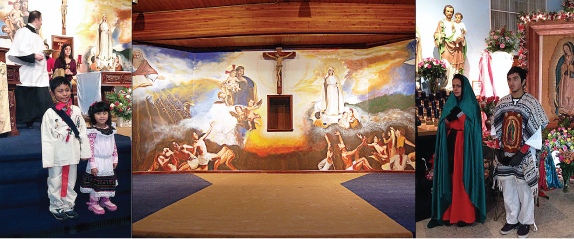
Another blow to Latino Catholics
MORE IN THIS SECTION
As the Archdiocese of Philadelphia merges parishes in an effort to improve finances, another Latino community feels the impact
Bensalem, just northeast of Philadelphia in Bucks County, has seen a tremendous growth in its Latino population in the past decade or so. While the overall population of Bensalem township declined by 1.03 percent between the census of 2000 and 2010, the Latino population increased by 102.50 percent. Almost 9 percent of the total population is now Latino.
And many of those Latinos worshipped every Sunday at noon and every Holy Day at 8 p.m., in Spanish, at Our Lady of Fatima Church on Street and Mechanicsville Roads.
As recently as this April, the church hosted classes to help adults prepare to take the citizenship exam, and workshops to help young undocumented immigrants fill out deferred action (DACA) applications.
A popular local soccer tournament took place on its grounds with its parishioners' involvement; and the Spanish-language services it extended included youth and prayer groups, Posada and Three Kings celebrations, and an annual Via Crucis as part of its Lenten celebrations.
The church also saw, every December 12th, a fantastic outpouring of devotion on the feast day of Our Lady of Guadalupe. The Mexican community came out in force — for liturgical dances in traditional matachín headdresses, children dressed as saints, and reenacted religious tableaux that often tipped the complete celebration over the two- or three-hour mark.
But in its announcement of June 1, the Archdiocese of Philadelphia has decided to merge Our Lady of Fatima Parish into St. Charles Borromeo Parish, a parish which up until now has not had even one designated Spanish-language Mass, no less any of the other Latino-targeted ministries of Our Lady of Fatima.
No parish merger or closure is a popular choice, but this one is puzzling.
By the Archdiocese's own best indicator for parish growth — number of baptisms — the 2012 figure for Our Lady of Fatima is just shy of double that of St. Charles Borromeo, and the number of marriages performed is exactly double. Why subsume the newer parish that serves a growing population into the older and more sluggish one — especially when the additional miles to be traveled between church locations might become an obstacle?
The distance between the two churches is approximately three miles, which doesn't seem extraordinary until you realize that undocumented immigrants cannot get drivers licenses in Pa., and so a number of Our Lady of Fatima's parishioners will be impacted.
We have in the past noted the municipal and archdiocesan shortsightedness in allowing La Milagrosa — a church that by its stone walls gave evidence of the history of Puerto Rican and Latino Catholic community growth in Philadelphia — to be shuttered. The wounds of that closure are still open in the Latino Catholic community, and the distance it has prompted between community and church officials is not likely to be bridged for a long time.
Our Lady of Fatima was not a Latino Catholic center for same amount of time as La Milagrosa but it, too, encloses history in its walls — in this case of the immigrant Latino community that has contributed to what vitality the Catholic Church in the United States, as a whole, can claim.
Like parishioners of La Milagrosa who now must go to Mass in a Cathedral Basilica that seems less intimately theirs, the Latino parishioners of Our Lady of Fatima will be going to a church without a trace of themselves inside. And that will be a loss.
You see, Our Lady of Fatima's sanctuary was literally covered with Latino traces. Colombian artist José Gerardo Rico painted the mural behind the church's altar when he was a parishioner there, and every Mass that took place in that structure was celebrated in front of it.
Think about it: Every Sunday, in English and in Spanish, it was a visible acknowledgement that the Latino community is here, is part, is thriving. It makes a difference — in religion as in politics as in media — and frankly, we Latinos experience it far too infrequently.
This merger might have been the opportunity to do so, folding old into new, favoring the dynamic over the static ... but instead, it is just another moment in which our history — we — disappear.






LEAVE A COMMENT:
Join the discussion! Leave a comment.